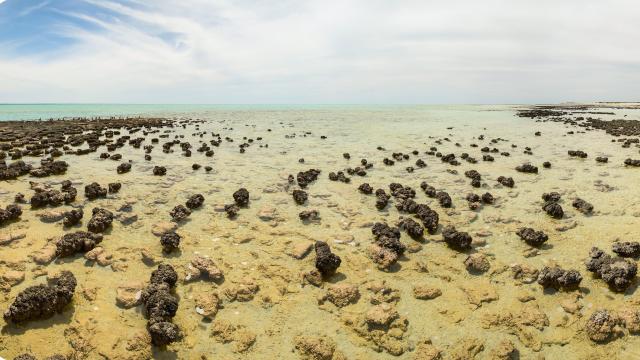The story of life on Earth can’t be told without photosynthesis, the process by which plants (and some other lifeforms) convert sunlight into chemical energy. Now, a team of researchers has announced the discovery of fossilized photosynthetic structures—the oldest yet known—from a staggering 1.75 billion years ago.
The structures belong to microfossils of Navifusa majensis, a presumed cyanobacteria found in northern Australia. Cyanobacteria are a type of microorganism that get energy from oxygenic photosynthesis, by which water and carbon dioxide are converted—using energy from sunlight—into glucose and oxygen. Thus, the ancient bacteria help scientists understand how one of the most fundamental life processes on Earth arose. The team’s research is published today in Nature.
“This discovery extends the fossil record of such internal membranes by at least 1.2 billion years,” said Emmanuelle Javaux, a biologist at the University of Liège in Belgium and a co-author of the study, in an email to Gizmodo. “The arrangement of these membranes in fossil cells allows their unambiguous identification as cyanobacteria actively performing early oxygenic photosynthesis at the time of death 1.75 billion years ago!”
In other words, the fossil is a remarkable window into a fundamental process on Earth, one that gave rise to life as we know it. Australia is rich ground for fossils of bacteria, which shed light on some of the earliest life on Earth. Indeed, the oldest known evidence for life on Earth comes in the form of nearly 3.5-billion-year-old stromatolites, layered concretions of ancient microbes.

About a billion years after those oldest signs of life—and hundreds of millions of years before the microfossils studied by the team lived—Earth underwent the Great Oxidation Event, a point when oxygen was produced much faster than before. Exactly when oxygenic photosynthesis evolved in cyanobacteria in relation to the Great Oxidation Event is unknown.
Though the N. majensis studied by the recent team is younger than the oldest stromatolites, it puts another data point in the timeline of oxygenic photosynthesis. Previous research has pointed out that the bacterial lineages in which photosynthesis evolved may not be around today, so microfossils of such organisms are key for understanding how that evolution took place. Cyanobacteria are also thought to be the ancestor of chloroplasts in plants, making their fossils the perfect subjects for understanding photosynthesis’ origins.
Javaux’s team studied fossil assemblages from Australia, the Democratic Republic of the Congo, and the Canadian Arctic in the hopes that they could identify cyanobacteria from them. Though taxa like N. majensis have been known for a long time, Javaux said, their identification can be difficult due to their simple morphology.
The team identified the microstructures in N. majensis as thylakoids, a type of membrane-bound structure that exists in plant chloroplasts and some modern cyanobacteria. Thus, they determined that the minimum age for the split between cyanobacteria with thylakoids and those without them was roughly 1.75 billion years ago.
While the timeline of oxygenic photosynthesis now has another timepeg, the new findings don’t provide much insight into when photosynthesis evolved in relation to the Great Oxidation Event. However, more fossils like the thylakoid-bearing N. majensis could provide some answers.
